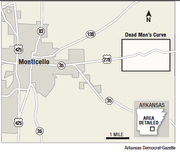The second phase of work on curves on U.S. 278 in Drew County, which was sparked by the death of a 21-year-old woman in a traffic crash, began Monday, the Arkansas Highway and Transportation Department said.
The August death of Carly Avery, a civil engineering intern from Mississippi State University, galvanized members of First United Methodist Church in Monticello. They sent a letter signed by 52 church members requesting that something be done about what is known locally as "dead man's curve," which the department acknowledged has been the site of several roadway-departure crashes in recent years, especially by drivers unfamiliar with the highway.
In December, the department announced a series of improvements, the first of which was replacing the top 2 inches of asphalt on the section of the highway, which is 2 miles east of Monticello. New signs were also installed.
The new driving surface and associated painted striping along the route provide increased traction and visibility through the area, according to the department.
"The roadway is well marked now," said Danny Straessle, a department spokesman.
The attention has been welcomed by the community.
"Everyone's very happy about what appears to be a very prompt and quick response by the Highway Department," said Cliff Gibson, a Monticello attorney and member of the church who wrote the letter. "Everybody's just very pleased. It's government at its best."
On Monday, crews installed rumble strips along the shoulders and rumble stripes on the centerline through the curves. Both are uniform grooves cut into the pavement. When a vehicle tire rolls over the grooves, it generates a noise, alerting motorists that their vehicles are leaving the travel lane.
The work was accomplished using a rolling lane closure, with periodic flagging operations used to control traffic.
The second phase is expected today when new paint will be put down to replace the paint damaged by the grooves, Straessle said.
Later this summer, crews are scheduled to install a high-friction surface treatment through the westernmost curve of the route. The treatment is a relatively new process that has yielded good results in reducing the number of wet-pavement crashes in areas where it has been installed.
In the Aug. 1 crash, Avery, who was living in Monticello during a summer internship at Clearwater Paper's Cypress Bend mill in Arkansas City, failed to negotiate the curve in the rain while driving to work. The car crossed into the westbound lanes and into the path of a 2014 Freightliner tractor-trailer, according to Arkansas State Police.
Days later, a fellow mill employee, Kenneth Roberts, asked the members of his adult Sunday School class at the church to pray for Avery's family. They prayed, but they also decided to do more.
The class asked Gibson to write a letter to state highway officials requesting that they take out the curve.
Even before they received the Aug. 10 letter, some Highway Department members took note of the crash and suggested the agency look at installing rumble strips at the location. A safety study to document the rate of crashes and what the department can do to mitigate them was initiated.
The study found that the location had fatal and serious crashes at a rate below the statewide average. But its overall crash rate was above the statewide average, and crashes when the pavement was wet occurred at a rate three times the statewide average.
The study's recommendations, which included the rumble strips, also called for straightening the curve. But state highway officials said that process would take far longer to do. In the meantime, the department said it will evaluate the effect of the changes it does make and schedule the realignment as "funds and conditions warrant."
Metro on 03/24/2015
